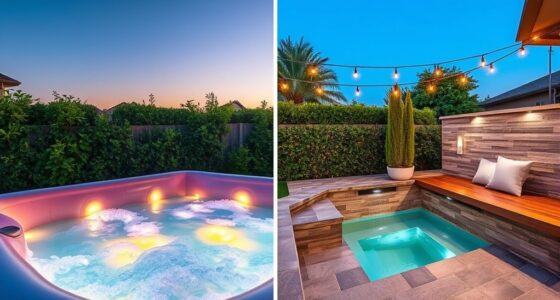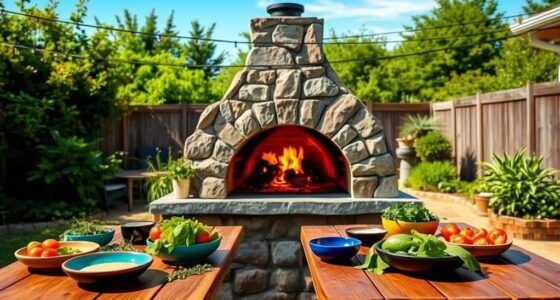Creating a DIY vertical garden is an excellent way to save space while adding beauty to your environment. By using simple wall planters, repurposed containers, or hydroponic systems, you can transform small areas into lush green displays filled with herbs, flowers, or veggies. These gardens not only maximize limited space but also improve air quality and insulation. Keep exploring to discover easy techniques and creative ideas to build your own vertical garden and enhance your surroundings.
Key Takeaways
- Use affordable materials like pallets, wall-mounted planters, or recycled containers for easy DIY vertical garden setups.
- Incorporate simple watering systems such as drip irrigation or self-watering planters to minimize maintenance.
- Arrange plants in layers or patterns to maximize visual appeal and space utilization.
- Select suitable plants based on environment, ensuring they thrive vertically and require minimal care.
- Customize your vertical garden with decorative elements to enhance beauty and integrate seamlessly with your space.

Have you ever wondered how to turn a small space into a lush, green oasis? Vertical gardens make this possible by transforming limited areas into vibrant, thriving green environments. Instead of spreading out horizontally, you grow plants upward, making the most of every inch of your balcony, patio, or even indoor wall. This efficient use of space means you can accommodate more plants in less room, leading to increased yields especially if you’re growing herbs, vegetables, or flowers. In urban settings where horizontal space is scarce, vertical gardens open the door to gardening, helping you bring greenery into city life and improving the overall atmosphere.
Vertical gardens turn small spaces into lush, green oases, maximizing growth in limited areas.
There are various structures you can choose from to suit your environment and style. Whether it’s a simple wall-mounted planter, a freestanding vertical frame, or a complex green wall, each option provides a creative way to display your plants. Growing vertically also reduces the need for large ground areas, so even small balconies or tiny yards can become lush gardens. You can layer plants, mix different types, and create eye-catching arrangements that add beauty and texture to your space. Plus, with the adaptability of vertical gardens, you can choose to include flowers, herbs, or even small vegetables, making it both functional and decorative.
Beyond aesthetics, vertical gardens offer significant environmental benefits. They help prevent soil erosion by containing soil within the structure, reducing runoff and preserving soil health. Many vertical systems are designed to be water-efficient, often incorporating self-watering or drip irrigation systems that use less water than traditional gardening. These gardens also improve air quality by filtering pollutants and releasing oxygen, making your urban environment healthier. Additionally, they can provide insulation and cooling effects, leading to energy savings in your home. Growing produce locally reduces transportation emissions, further lowering your carbon footprint.
Design-wise, vertical gardens boost visual appeal and can be customized to match your architectural style. They allow for creative plant arrangements, adding layers and textures that bring life to dull walls. Whether you want an indoor oasis or an outdoor living wall, these systems are versatile and adaptable. They’re especially suitable for senior gardeners or anyone with limited mobility, as they require less bending and physical effort. Maintenance is generally simpler, and many systems can be automated, reducing ongoing labor and costs. With affordable materials and DIY options, building your vertical garden can be both cost-effective and satisfying.
Incorporating innovative techniques like hydroponics or using sustainable materials makes your vertical garden more efficient and eco-friendly. Hydroponic systems, which grow plants without soil, can accelerate plant growth and maximize space. These advanced methods can accelerate plant growth and reduce resource use. Overall, DIY vertical gardens are a smart way to save space, foster environmental sustainability, and add beauty to any area. They transform small, overlooked spaces into lively, productive, and attractive gardens you can enjoy every day.
Frequently Asked Questions
What Are the Best Plants for Indoor Vertical Gardens?
You should consider plants like Chinese Evergreen, Peperomia, and Golden Pothos for your indoor vertical garden. These low-maintenance options thrive in various light conditions and add lush greenery. Ferns and air plants are perfect for humid spaces, while orchids and flowering vines bring elegance and fragrance. Edible choices like strawberries and dwarf tomatoes also work well, giving your vertical garden both beauty and practical harvests.
How Often Should I Water My Vertical Garden?
Imagine your vertical garden basking in the morning sun, droplets glistening on leaves. You should water it based on your climate and season, typically every 2-3 days in spring, daily or twice daily in summer, and less often in fall and winter. Keep the soil moist but not soggy, checking moisture levels regularly. Adjust watering as needed, and always water early to maximize absorption and reduce evaporation.
Can Vertical Gardens Be Built Outdoors in Winter?
Yes, you can build outdoor vertical gardens in winter, but you need to plan carefully. Choose cold-hardy plants like evergreens or deciduous varieties that withstand winter. Use frost-resistant materials for your planters and protect them with insulation like burlap. Position your garden in a sheltered spot, and guarantee your irrigation system is winter-proof or disconnected during extreme cold. Regular maintenance and snow removal will help your garden survive and thrive.
What Materials Are Safest for DIY Vertical Garden Structures?
When choosing materials for your DIY vertical garden, safety is key. Opt for naturally rot-resistant woods like cedar or pressure-treated wood made after the early 2000s, as they’re safer for plants. Avoid old treated woods with arsenate. Metal fencing and synthetic plastics are also safe, provided they’re free from harmful chemicals. Always verify the history of reclaimed materials and use non-toxic, weather-resistant options to guarantee your garden stays healthy and safe.
How Do I Prevent Pests in My Vertical Garden?
Your garden’s pest problem might feel like an unstoppable army, but you can take control with natural methods. Attract beneficial insects like ladybugs, use neem oil or insecticidal soaps, and plant companion species to repel pests. Employ physical barriers, hand-pick pests, and keep your space tidy. Regularly monitor and maintain your plants to catch issues early, making your vertical garden a pest-free paradise that thrives naturally.
Conclusion
With a DIY vertical garden, you can transform even the tiniest space into a lush, vibrant paradise. It’s easier than you think to create a stunning green oasis that breathes life into your home and lifts your spirits. Imagine having a living masterpiece right on your wall—it’s like having a secret garden at your fingertips! So, roll up your sleeves and start planting—your dream garden is just a few pots away, waiting to explode with beauty.









